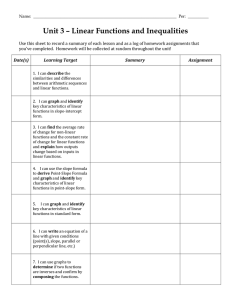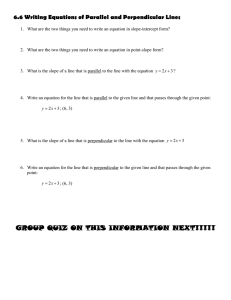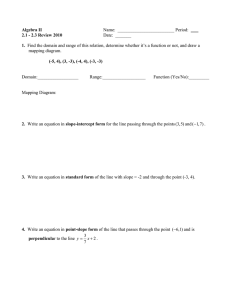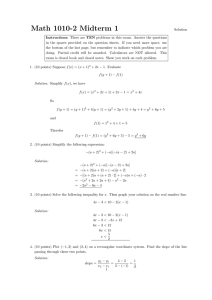Algebra I Notes Linear Functions & Inequalities Part II Unit 5
advertisement
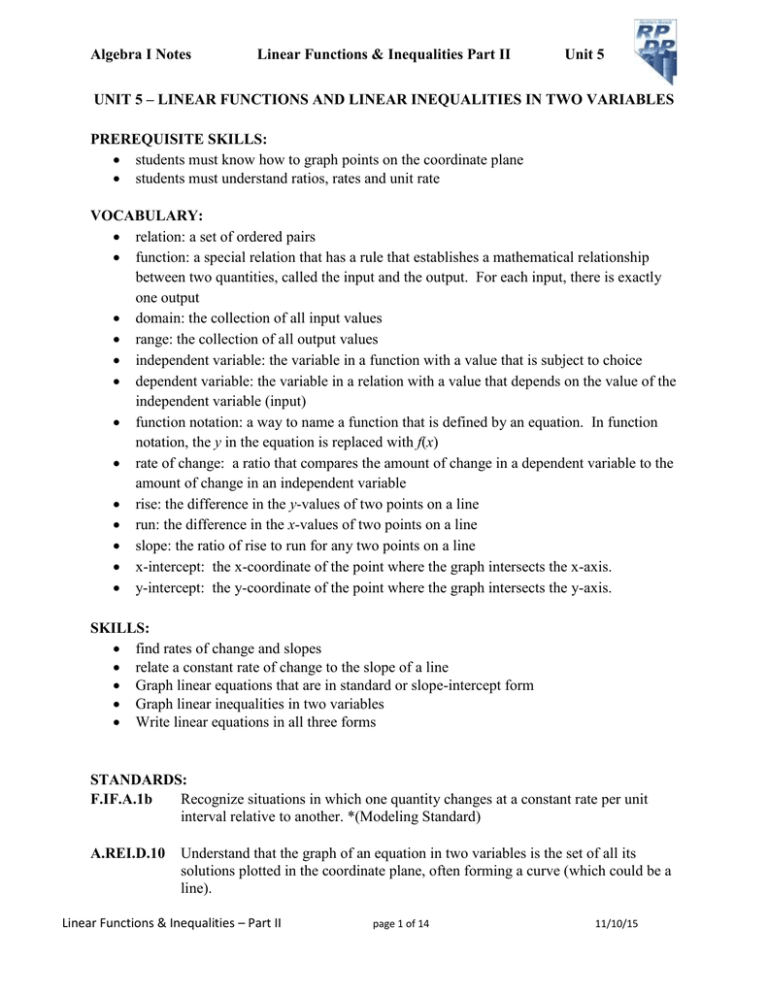
Algebra I Notes Linear Functions & Inequalities Part II Unit 5 UNIT 5 – LINEAR FUNCTIONS AND LINEAR INEQUALITIES IN TWO VARIABLES PREREQUISITE SKILLS: students must know how to graph points on the coordinate plane students must understand ratios, rates and unit rate VOCABULARY: relation: a set of ordered pairs function: a special relation that has a rule that establishes a mathematical relationship between two quantities, called the input and the output. For each input, there is exactly one output domain: the collection of all input values range: the collection of all output values independent variable: the variable in a function with a value that is subject to choice dependent variable: the variable in a relation with a value that depends on the value of the independent variable (input) function notation: a way to name a function that is defined by an equation. In function notation, the y in the equation is replaced with f(x) rate of change: a ratio that compares the amount of change in a dependent variable to the amount of change in an independent variable rise: the difference in the y-values of two points on a line run: the difference in the x-values of two points on a line slope: the ratio of rise to run for any two points on a line x-intercept: the x-coordinate of the point where the graph intersects the x-axis. y-intercept: the y-coordinate of the point where the graph intersects the y-axis. SKILLS: find rates of change and slopes relate a constant rate of change to the slope of a line Graph linear equations that are in standard or slope-intercept form Graph linear inequalities in two variables Write linear equations in all three forms STANDARDS: F.IF.A.1b Recognize situations in which one quantity changes at a constant rate per unit interval relative to another. *(Modeling Standard) A.REI.D.10 Understand that the graph of an equation in two variables is the set of all its solutions plotted in the coordinate plane, often forming a curve (which could be a line). Linear Functions & Inequalities – Part II page 1 of 14 11/10/15 Algebra I Notes Linear Functions & Inequalities Part II Unit 5 F.IF.C.7a Graph linear and quadratic functions and show intercepts, maxima, and minima. *(Modeling Standard) F.LE.A.2 Construct linear and exponential functions, including arithmetic and geometric sequences, given a graph, a description of a relationship, or two input-output pairs (include reading these from a table). *(Modeling Standard) F.IF.B.4-1 For a linear, exponential, or quadratic function that models a relationship between two quantities, interpret key features of graphs and tables in terms of the quantities, and sketch graphs showing key features given a verbal description of the relationship. Key features include: intercepts; intervals where the function is increasing, decreasing, positive, or negative; relative maximums and minimums; symmetries; and end behavior. *(Modeling Standard) F.IF.C.7a Graph linear and quadratic functions and show intercepts, maxima, and minima. *(Modeling Standard) N.Q.A.1 Use units as a way to understand problems and to guide the solution of multi-step problems; choose and interpret units consistently in formulas; choose and interpret the scale and the origin in graphs and data displays. F.IF.B.6-1 Calculate and interpret the average rate of change of a linear, exponential, or quadratic function (presented symbolically or as a table) over a specified interval. Estimate the rate of change from a graph of a function over a specified interval. *(Modeling Standard) A.CED.A.2-1 Create linear, exponential, and quadratic equations in two or more variables to represent relationships between quantities and graph equations on coordinate axes with labels and scales. Limit exponentials to have integer inputs only. *(Modeling Standard) A-CED.A.3-1 Represent constraints by linear equations or inequalities, and by systems of linear equations and/or inequalities, and interpret solutions as viable or non-viable options in a modeling context. For example, represent inequalities describing nutritional and cost constraints on combinations of different foods. *(Modeling Standard) A.REI.D.12-1 Graph the solutions to a linear inequality in two variables as a half-plane (excluding the boundary in the case of a strict inequality), and graph the solution set to a system of linear inequalities in two variables as the intersection of the corresponding half-planes. Linear Functions & Inequalities – Part II page 2 of 14 11/10/15 Algebra I Notes Linear Functions & Inequalities Part II Unit 5 LEARNING TARGETS: 5.1 To identify a linear function from a table, graph, or equation. 5.2 To use intercepts to graph linear functions in standard form. 5.3 To relate constant rate of change and slope in linear relationships. 5.4 To graph linear equations using slope intercept form. 5.5 To graph linear inequalities in two variables. 5.6 To create a linear equation in slope-intercept form. 5.7 To create a linear equation in point-slope form. 5.8 To create a linear equation in standard form. BIG IDEA: The concept of slope is important because it is used to measure the rate at which changes are taking place. In real-life problems, we often need to explore and understand how things change and about how one item changes in response to a change in another item. Describe the similarities and differences between equations and inequalities – including solutions and graphs. Linear functions can be created from various forms of information. The solutions to real-word problems can be found by modeling them with equations and graphs. Notes, Examples and Exam Questions Units 5.6, 5.7 and 5.8 To create a linear equation in slope-intercept form, To create a linear equation in point-slope form and To create a linear equation in standard form. Slope-Intercept Form of an Equation of a Line: y mx b m = slope, b = y-intercept Writing the Equation of a Line Given the Slope and y-Intercept Ex 1: Write the equation of a line with a slope of 4 and a y-intercept of −6. Use slope-intercept form with m = 4 and b = −6. y mx b y 4 x 6 or y 4 x 6 Linear Functions & Inequalities – Part II page 3 of 14 11/10/15 Algebra I Notes Linear Functions & Inequalities Part II Unit 5 Writing the Equation of a Line Given the Graph Ex 2: Write the equation of the line shown in the graph. The y-intercept is 3, as seen in the graph. To find the slope, use the two points shown in the graph. Starting from the point on the left, we would step down 2 and right 4, so the slope is 2 1 . 4 2 Use slope-intercept form with m y mx b 1 and b 3 . 2 1 y x3 2 Application Problems Ex 3: Xavier weighed 220 pounds and lost 2 pounds a month for 6 months. Write a linear equation to model Xavier’s weight, W, over M months. Use the model to find how much Xavier weighed after 6 months. The y-intercept represents Xavier’s beginning weight at 0 months: b = 220 The slope (rate of change) represents Xavier’s change in weight each month. (Note: Because he is losing weight, the slope will be negative.) m 2 Equation: W 2 M 220 To find Xavier’s weight after 6 months, let M = 6. W 2 6 220 208 lbs. Ex 4: A taxi charges a flat fee of $10 plus $1.50 per mile. Write a linear equation that represents the cost, C, of a taxi ride for M miles. The y-intercept represents the initial fee (at 0 miles): b = 10 The slope (rate of change) represents the fee per mile: m = 1.50 Equation: C 1.5M 10 Linear Functions & Inequalities – Part II page 4 of 14 11/10/15 Algebra I Notes Linear Functions & Inequalities Part II Unit 5 You Try: 1. Write the equation of a line in slope-intercept form with a slope of 1 and a y-intercept of −5. 3 2. Write the equation of the line shown in the graph in slope-intercept form. A. B. QOD: When writing a linear model for an application problem, describe what the slope and y-intercept represent. Sample Exam Questions 1. What is the equation of the line in slope-intercept form passing through the points in the table? x y −2 −3.5 A. y 1 x 3 2 B. y 1 x4 2 0 −3 2 −2.5 4 −2 6 −1.5 1 C. y x 1 4 D. y 1 x 3 4 Ans: D Linear Functions & Inequalities – Part II page 5 of 14 11/10/15 Algebra I Notes Linear Functions & Inequalities Part II Unit 5 2. Use the graph below. What is the equation of the line in the graph? A. y 2 x 1 B. y 2 x 2 C. y 2 x 1 D. y 2 x 2 Ans: D Skill: translate among the different forms of linear equations including slope-intercept, point-slope, and standard form. Skill: identify parallel, perpendicular, and intersecting lines by slope. Point-Slope Form of a Linear Equation: y y1 m x x1 m = slope, x1, y1 = point on the line Teacher Note: This form is used frequently in subsequent courses – be sure to emphasize! Note: This is simply the slope formula rewritten. m y2 y1 Clear the fraction by cross-multiplying, we have m x2 x1 y2 y1 x2 x1 Linear Functions & Inequalities – Part II page 6 of 14 11/10/15 Algebra I Notes Linear Functions & Inequalities Part II Unit 5 Writing an Equation of a Line Given a Point and the Slope Ex 5: Write an equation of the line that passes through the point 3,5 and has a slope of 7 in pointslope form. Use point-slope form with x1, y1 3,5 and m 7 . y y1 m x x1 y 5 7 x 3 y 5 7 x 3 Ex 6: Write an equation of the line that passes through the point 2, 1 and has a slope of 1 in slope2 intercept form. Use point-slope form with x1, y1 2, 1 and m y y1 m x x1 y 1 1 . 2 1 1 x 2 y 1 x 2 2 2 To convert to slope-intercept form, solve the point-slope form equation for y. y 1 1 1 x 1 y x 2 2 2 Writing an Equation of a Line Given Two Points Step One: Find the slope using the two points in the slope formula. Step Two: Use the slope and one of the points (either one) in the point-slope equation. Step Three: Write the equation in the form required for the problem. Ex 7: Write the equation of the line that passes through the points 4,7 and 1, 5 in slope-intercept form. Step One: Find the slope using the two points in the slope formula. m 7 5 12 4 4 1 3 Step Two: Use the slope and one of the points (either one) in the point-slope equation. We will use the point 4,7 . y y1 m x x1 y 7 4 x 4 y 7 4 x 4 Linear Functions & Inequalities – Part II page 7 of 14 11/10/15 Algebra I Notes Linear Functions & Inequalities Part II Unit 5 y 7 4 x 16 Step Three: Write the equation in the form required for the problem. y 4x 9 On Your Own: Work the problem above again, using 1, 5 as the point in the point-slope equation. Writing an Equation of a Line Given the Graph Ex 8: Write the equation of the line shown in the graph in slope-intercept form. We will follow the same steps in the previous example using the points on the graph. Step One: Find the slope using the two points on the graph. Starting at the point on the left, we would step up 3 and right 2 to get to the other point, so the slope is m 3 . 2 Step Two: Use the slope and one of the points (either one) in the point-slope equation. We will use the point 3,0 . y y1 m x x1 y 0 3 3 x 3 y x 3 2 2 Step Three: Write the equation in the form required for the problem. y 3 9 x 2 2 Slopes of Parallel Lines Activity: Graph the following lines by hand on the same coordinate plane. y 3x 6 y 2 3 x 4 6 x 2 y 12 What do you notice about the lines? (They are parallel.) Find the slope of the lines using the equation. What do you notice about the slopes? (They are the same.) Conclusion: Parallel lines have equal slopes. Linear Functions & Inequalities – Part II page 8 of 14 11/10/15 Algebra I Notes Linear Functions & Inequalities Part II Unit 5 Ex 9: Write an equation of the line parallel to the line y 2 x 1 that passes through the point 4, 5 in point-slope form. Step One: Determine the slope of the given line. y 2 x 1 is in slope-intercept form with m 2 . Step Two: Determine the slope of the line parallel to the given line. Because parallel lines have equal slopes, the slope of the line parallel is also m 2 . Step Three: Write the equation of the parallel line in point-slope form using the slope found in Step Two and the point given in the problem. y y1 m x x1 y 5 2 x 4 y 5 2 x 4 Writing Equations of Perpendicular Lines Perpendicular Lines: two lines that intersect at a right angle. Perpendicular lines have slopes that are opposite reciprocals. Ex 10: Write an equation of the line perpendicular to the line y 7 1 x 1 that passes through the 3 point 1,7 in slope-intercept form. Step One: Determine the slope of the given line. y 7 1 1 x 1 is in point-slope form with m . 3 3 Step Two: Determine the slope of the line perpendicular to the given line. Because perpendicular lines have slopes that are opposite reciprocals, the slope of the line perpendicular is m 3 . Step Three: Write the equation of the perpendicular line in point-slope form using the slope found in Step Two and the point given in the problem. y y1 m x x1 y 7 3 x 1 Step Four: Write the equation in slope-intercept form. y 7 3x 3 y 3x 10 On Your Own: Graph the two lines to show they are perpendicular. Linear Functions & Inequalities – Part II page 9 of 14 11/10/15 Algebra I Notes Linear Functions & Inequalities Part II You Try: Write the equation of the line parallel to the line y 9,6 Unit 5 1 x 8 that passes through the point 3 in slope-intercept form. QOD: Describe the relationship of the equations of parallel lines and perpendicular lines. Sample Exam Questions 1. Write the equation y 3 A. y 1 x 1 2 B. y 1 x 1 2 C. y 1 x5 2 D. y 1 x7 2 1 x 4 in slope-intercept form. 2 Ans: C 2. Identify a point-slope equation of the line that passes through the point (–4, 5) and has 3 a slope of . 10 A. y 4 3 x 5 10 B. y 5 3 x 4 10 C. y 5 10 x 4 3 D. y 4 10 x 5 3 Ans: B Linear Functions & Inequalities – Part II page 10 of 14 11/10/15 Algebra I Notes Linear Functions & Inequalities Part II 3. Which is an equation of a line perpendicular to y Unit 5 2 1 x ? 5 3 2 A. y x 3 5 5 B. y x 2 2 C. y 5 x3 2 D. y = 3x + 3 Ans: C 4. Which equation represents the line that contains the point (–3, 14) and is parallel to the line 2 x y 5 ? A. y 14 2 x 3 B. y 14 2 x 3 C. y 14 1 x 3 2 D. y 14 1 x 3 2 Ans: A 5. What is the equation of the line that passes through the points (5, –1) and (4, –5)? (A) y 5 4 x 4 (B) y 5 4 x 4 (C) y 5 1 x 4 4 (D) y5 1 x 4 4 Ans: B Linear Functions & Inequalities – Part II page 11 of 14 11/10/15 Algebra I Notes Linear Functions & Inequalities Part II Unit 5 Standard Form of a Linear Equation: Ax By C ; where A, B, and C are real numbers and A and B are not both zero Rewriting an Equation of a Line in Standard Form Ex 11: Write the equation y 3 x 5 in standard form with integer coefficients. 4 Step One: Wipe out fractions to create integer coefficients by multiplying each term in the equation by 4. 3 4 y 4 x 4 5 4 y 3x 20 4 Step Two: Rewrite the equation so that the x and y terms are on one side, and the constant term is on the other side. 4 y 3x 20 or 3x 4 y 20 4 y 3x 20 20 3x 4 y 3x 4 y 20 Note: There is more than one way to write an equation of a line in standard form! It is preferred for the coefficient of the x to be positive and for both coefficients to be integers, not fractions. Writing a Linear Equation in Standard Form Given Two Points Ex 12: Write an equation of the line that passes through the points 2,4 and 1, 5 in standard form. Step One: Find the slope. m 4 5 9 3 2 1 3 Step Two: Use the slope and one of the points given to write the equation in point-slope form. y 4 3 x 2 y 4 3 x 2 Step Three: Rewrite the equation in standard form. y 4 3x 9 3x y 5 On Your Own: Write this equation in standard form 3 different ways. Linear Functions & Inequalities – Part II page 12 of 14 11/10/15 Algebra I Notes Linear Functions & Inequalities Part II Unit 5 Writing a Linear Equation in Standard Form Given the Graph Ex 14: Write the equation of the line shown in the graph in standard form. This is a vertical line with an x-intercept of −4, so the equation is x 4 . Application Problem Ex 14: Giovanni has $20 to spend on apples and grapes at the grocery store. Apples cost $2.00 per pound and grapes cost $1.25 per pound. Write a linear equation in standard form that models the different amounts of apples, a, and grapes, g, that Giovanni can buy for $20. Graph the line. Verbal Model: Price of Apples × Pounds of Apples + Price of Grapes × Pounds of Grapes = Total Cost Labels: Price of Apples = 2 Total Cost = 20 Algebraic Model: Pounds of Apples = a Price of Grapes = 1.25 Pounds of Grapes = g 2a 1.25g 20 Graph: Let a be the horizontal axis and g be the vertical axis. The a-intercept is 10 (let g = 0), and the g-intercept is 16 (let a = 0). Any point on the line is a possible combination of apples and grapes he can buy. You Try: 1. Write an equation in standard form with integer coefficients of the line that passes through the points 9, 2 and 3,2 . 2. Write an equation in standard form of the horizontal line and the vertical line that pass through the point 8,9 . QOD: Today we learned that there is more than one way to write an equation of a line in standard form. Is there more than one way to write an equation of a line in point-slope form? In slope-intercept form? Linear Functions & Inequalities – Part II page 13 of 14 11/10/15 Algebra I Notes Linear Functions & Inequalities Part II Unit 5 Sample Exam Questions 1. Write the equation y 2 1 x in standard form. 3 2 A. 6 y 4 x 3 B. 4 x 6 y 3 C. 2 x 6 y 1 D. y 4 x 3 Ans: B 2. Write the equation through (-6, 3) with undefined slope. A. y 3 B. y 6 C. x 6 D. x 3 Ans: C 3. Find an equation of the line passing through the two points. Write the equation in standard form. (4, 2) and (0,3) A. 6 x 3 y 9 B. 6 x 3 y 9 C. 5 x 4 y 12 D. 5 x 4 y 12 Ans: C Linear Functions & Inequalities – Part II page 14 of 14 11/10/15
